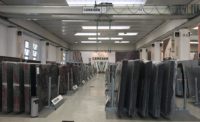This fall, I made my annual journey to Verona, Italy, to attend Marmomacc, the largest stone exhibition in the world. And as always, the show did not disappoint. The exhibition halls were filled with innovations -- from new stone products to advanced fabrication and quarrying equipment to environmentally friendly stone maintenance and installation products.
Textures and patterns seemed to be prominent at this year's event. Antolini Luigi, one of the largest Italian producers of stone, including many exotic materials, exhibited its new Natura Collection. The products in this collection featured various animal prints etched in stone. Antolini is also known for its beautiful Precioustone Collection. Many of the slabs in this line are decorated with Swarovski crystal.
Another company that caught my eye while touring the exhibition floor was Marblelace. The company exhibited a large display of intricately cut pieces of stone that resemble the look of lace. These stone pieces would be great as decorative pieces or could be used as screening.
Innovation also continues to shine at Pokarna. The Indian producer of natural stone and quartz products introduced new shades to its Quantra line, a series of engineered quartz surfaces. The new colors replicate the look of onyx and can be backlit. "This is the first time we are able to make onyx-looking quartz," said Gautum Jain, owner of Pokarna. Among the new colors are Contrail -- a shade of soft tan -- and Noctilucent -- a blend of grayish green.
A tool that would be of interest to the architectural and design community would be StoneXperience 3.0., which was introduced by Italian stone producer Marmi Bruno Zanet. The program shows customers how stone can be used within certain environments,
such as kitchens, living rooms, etc. This program is an updated version to the StoneXperience 1.0 visual, which can simulate an environment with 30 types of natural stone in 16 three-dimensional scenes. In addition, it allows the possibility of changing the layout of the floor and the color of the walls and the fittings.
Also while in Italy, I had the opportunity to join a group of architects on a tour of a Botticino marble quarry that sits high in the hills of Brescia. The quarry is owned by Ghirardi Marmi, a family business now in its third generation. The first quarries in the region were developed in Roman times, and today there are a total of 55 quarries in the area.
I always welcome the opportunity to get out in the "field" and observe stone-processing practices. Many of the quarry workers have been doing this for decades -- dealing with any obstacles that might come their way. For example, the day before our group's visit, there were torrential downpours that caused about 4 inches of mud at the site. We were given plastic "booties" to cover our shoes. Despite the effort, we still got muddy, but the visit was definitely worth it. We got to observe a bench of the quarrying falling and blocks being extracted. It reminds you that stone really is a product of nature. It's always amazing to witness the material in its raw state, and then think about how it is finished and shipped to projects around the world.





